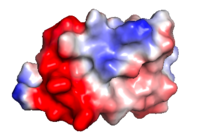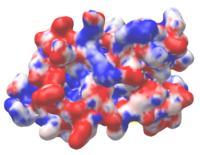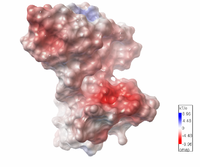Electrostatic potential maps
From Proteopedia
(Difference between revisions)
(→Gallery) |
(→Gallery) |
||
| Line 6: | Line 6: | ||
! scope="colgroup" colspan="3" | Protein is in the same orientation in all images. | ! scope="colgroup" colspan="3" | Protein is in the same orientation in all images. | ||
|- | |- | ||
| - | |style="width: | + | |style="width: 250;" width="250"| [[Image:1pgb-EPM-PyMOL.png|200 px]] |
| - | |style="width: | + | |style="width: 250;" width="250"| [[Image:1pgb-EPM-iCn3D.png|200 px]] |
| - | |style="width: | + | |style="width: 250;" width="250"| [[Image:1pgb-EPM-PyMOL.png|200 px]] |
|- | |- | ||
| Electrostatic potential map of protein [[1pgb]] rendered by [[PyMOL]]. | | Electrostatic potential map of protein [[1pgb]] rendered by [[PyMOL]]. | ||
Revision as of 17:38, 25 August 2024
It is revealing to visualize the distribution of electrostatic charges, electrostatic potential, on molecular surfaces. Most protein-protein and protein-ligand interactions are largely electrostatic in nature, via hydrogen bonds and ionic interactions. Their strengths are modulated by the nature of the solvent: pure water or high ionic strength aqueous solution.
Gallery
| Protein is in the same orientation in all images. | ||
|---|---|---|

| 
| 
|
| Electrostatic potential map of protein 1pgb rendered by PyMOL. | image2 | yyy |
 | Electrostatic potential map of 1tsj made with the Embedded Python Molecular Viewer from the Center for Computational Structural Biology of the Scripps Research Institute. |
Click on the image to enlarge. |}
See Also
- Electrostatic interactions in Proteopedia.
- Jmol/Electrostatic potential methods.
- Isopotential Map in Wikipedia
- Delphi Web Server
